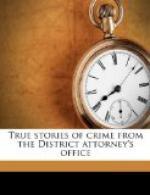Then something happened which once more dragged Flechter into the limelight. Editors rushed to their files and dusted the cobwebs off the issues containing the accounts of the trial. The sign of the gilded fiddle became the daily centre of a throng of excited musicians, lawyers and reporters. The lost Stradivarius—the great “Duke of Cambridge”—the nemesis of Bott and of Flechter—was found—by Flechter himself, as he claimed, on August 17, 1900. According to the dealer and his witnesses the amazing discovery occurred in this wise. A violin maker named Joseph Farr, who at one time had worked for Flechter and had testified in his behalf at the trial (to the effect that the instrument produced in the police court was not Bott’s Stradivarius) saw by chance a very fine violin in the possession of a family named Springer in Brooklyn, and notified Flechter of the fact. The latter, who was always ready to purchase choice violins, after vainly trying for a long time to induce the Springers to bring it to New York, called with Farr upon Mrs. Springer and asked to examine it. To his utter astonishment she produced for his inspection Bott’s long-lost Stradivarius. Hardly able to control his excitement Flechter immediately returned to New York and reported the discovery to the police, who instantly began a thorough examination of the circumstances surrounding its discovery.
The District Attorney’s office and the Detective Bureau were at first highly suspicious of this opportune discovery on the part of a convicted felon of the precise evidence necessary to clear him, but it was soon demonstrated to their pretty general satisfaction that the famous Stradivarius had in fact been pawned in the shop of one Benjamin Fox on the very day and within an hour of the theft, together with its case and two bows, for the insignificant sum of four dollars. After the legal period of redemption had expired it had been put up at auction and bid in by the pawnbroker for a small advance over the sum for which it had been pawned. It lay exposed for purchase on Fox’s shelf for some months, until, in December, 1895, a tailor named James Dooly visited the shop to redeem a silver watch. Being, at the same time, in funds, and able to satisfy his taste as a virtuoso, he felt the need of and bought a violin for ten dollars, but, Fox urging upon him the desirability of getting a good one while he was about it, was finally persuaded to purchase the Bott violin for twenty dollars in its stead. Dooly took it home, played upon it as the spirit moved, and whenever in need of ready money brought it back to Fox as security, always redeeming it in time to prevent its sale. One day, being at Mrs. Springer’s, where he was accustomed to purchase tailor trimmings, he offered it to her for sale, and, as her son was taking violin lessons, induced her to buy it for thirty dollars. And in the house of the Springers it had quietly remained ever since, while lawyers and prosecutors wrangled and thundered and witnesses swore positively to the truth, the whole truth and nothing but the truth, to prove that Flechter stole the violin and tried to sell it to Durden.




